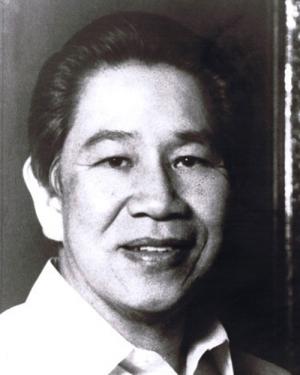Locsin, Leandro V.
HS 1947
DECEASED
1974
DLSAA Distinguished Lasallian Awardee
When Leandro V. Locsin finished high school at La Salle in 1947, nobody ever thought that he would become an internationally renowned architect, art collector and the owner of an outstanding collection of Chinese ceramics found in the Philippines.
Lindy, as he is known to everybody, comes from Silay in Negros Occidental province. He was named after his paternal grandfather, the first governor of Negros during the American regime. He completed his elementary and high school studies at Taft Avenue, then studied music at the University of Santo Tomas, where he obtained an Associate in Arts degree with piano as his major. Then he switched to architecture, graduating in 1953. Had he continued with a career in music, he might have become one
of the major concert pianists of the country. As it was, six years after graduating as an architect in 1969, he received the prestigious Ten Outstanding Young Men or TOYM award, the Junior Chamber of Commerce's recognition for bright young men. This marked the beginning of a series of awards. Prior to this, he had designed the Chapel of the Holy Sacrifice at the University of the Philippines in Diliman, Quezon City, and the chapel in Fabrica, Negros. These two edifices drew the attention of builders for their boldness in the use of forms and elements suggestive of traditional architecture. The late Fernando Zobel of Ayala Corporation was impressed by his work, and commissioned him to design all future Ayala edifices in the fast growing suburb of Makati, beginning with the Monterray Apartments. Since then, Lindy has designed 71 residences, 77 buildings (35 of which are major offices), 17 public edifices composed of various complexes or centers, nine chapels including St. Andrew's Church in Bel-Air Village, and seven hotels including the Hyatt, the Intercontinental, the Plaza, the Manila Hotel, and the Mandarin. He was the architect of the Cultural Center and the Folk Arts Theater, which set an unprecedented record of having been completed in less than three months at the request of Mrs. Imelda Romualdez Marcos. Lindy personifies the triumphant emergence of a modern Filipino architecture distinctive in style and quality. His use of brown tuff (locally called adobe) as opposed to the usual gray, the unusual sizes of these materials, the use of dark pebbles on the walls and floors, the revival of the traditionally large Filipino roof, the use of lattices in the arches, buffers or ramas, the wide two-meter eaves and the meticulous treatment of under-the-eaves for minimizing tropical glare and maximizing ventilation — all these and many other features he introduced, developed and popularized. They have become integral parts of contemporary architecture of the Philippines. He is married to Cecilia Yulo, daughter of the late Speaker Jose Yulo, whose family owns the vast Canlubang Estate. With Cecilia he authored the coffee-table book “Oriental Ceramics Discovered in the Philippines” in 1967. Ten years later Nicholas Polites, an American writer-architect, published a book entitled “The Architecture of Leandro V. Locsin”. The December issue that year of Reader's Digest called him “Manila's Master Builder”. Working with planners, engineers, economists and ecologists, Locsin is in the process of turning the Canlubang area into a satellite city about twice the area of Manila with a projected population of one million. His admirers claim that the Canlubang metropolis will be a model of modern city planning. The tremendous load of work has been hard on his health, and three years ago he underwent heart bypass surgery in Houston, Texas. Since then he has been living quietly with his wife and two sons in the United States.





